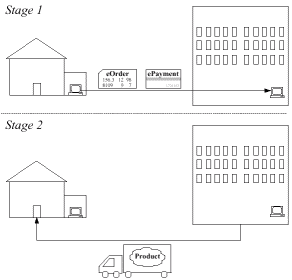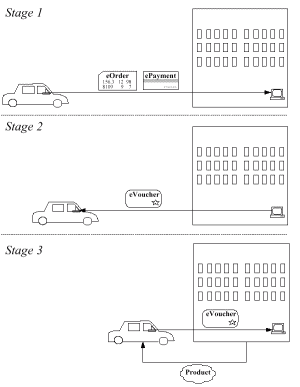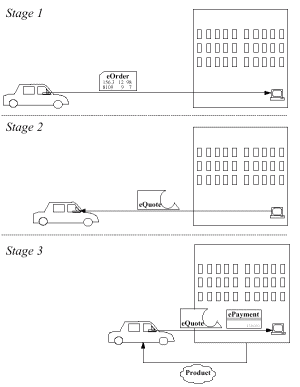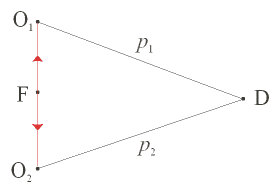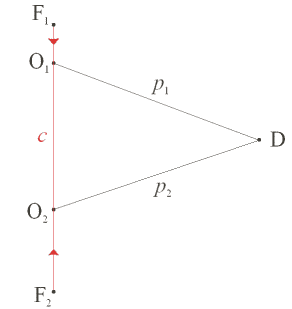Overview


- Background on En Route Commerce
- An Example: Real-Time Pricing of Taxi Services
- Future Research
Introduction


- Electronic Commerce
- Buying and selling goods using electronic transaction
processing technologies (that require little or no intervention
on the part of the buyer or seller).
- En Route Commerce
- Electronic commerce conducted while traveling from one
location to another.
Examples of En Route Commerce


- Gasoline (pricing, services)
- Hotel (pricing, availability, reservations, room key)
- Restaurants (menu, reservations, order)
- Parking (pricing, availability, reservations)
- Taxi Services (pricing, reservations)
Electronic Commerce Transactions


En Route Commerce Transactions


En Route Commerce Transactions (cont.)


An Application: Taxi Services


- The Past:
- Manual requests/reservations
- Drop fee and per mile charges (e.g., NYC) or zone-based
fares (e.g., DC)
- Cash payments
- Today/The Near Future:
- Electronic requests/reservations
- Electronic payment
- The Future:
Taxi Pricing: Assumptions


- Short, Frequent Auctions:
- Falling Price Auction:
- Firms announce prices for particular trips
- Individuals accept/reject
- Firms adjust prices
- \(\vdots\)
- All individuals receive "final" price
Modeling Assumptions


- Continuum of utility-maximizing passengers
- Continuum of homogeneous vehicles
- An available alternative (i.e., elastic demand)
- One time period/auction
- Small number of (or one) profit-maximizing firms
- One or more OD-pairs
Model


- Related Models:
- Spatial Price Equilibrium (Samuleson, 1952;
Takayama and Judge, 1971)
- Spatial Oligopoly (Weskamp, 1985; Harker, 1986;
Nagurney, 1987)
- Spatial Oligopoly with Arbitrageurs
(Friesz and Bernstein, 1992)
- Important Difference:
- Customers can move
- "Product" can only be moved by the firm
A Monopoly Example


A Monopoly Example (cont.)


- Demand:
- \(p_1 = 4 - q_1\)
- \(p_2 = 6 - 2 q_2\)
- Costs:
- \(C' = 0.2\) for all trips
A Monopoly Example (cont.)


- High Walking Cost:
- \(p_1 = 2.10, p_2 = 3.10\)
- \(q_1 = 1.90, q_2 = 1.45\)
- \(\pi = 7.82\)
- Walking Cost of 0.5:
- \(p_1 = 2.27, p_2 = 2.27\)
- \(q_1 = 1.73, q_2 = 1.62\)
- \(\pi = 7.73\)
An Oligopoly Example


An Oligopoly Example (cont.)


- Demand:
- \(p_1 = 4 - q_1\)
- \(p_2 = 13 - 2q_2\)
- Costs:
- \(C'_1 = 0.2 + c\)
- \(C'_2 = 2.1 + c\)
- \(c = 3.0\)
An Oligopoly Example (cont.)


- High Walking Cost:
- \(p_1 = 2.10, p_2 = 6.10\)
- \(q_{11} = 1.90, q_{12} = 1.45, \pi = 7.82\)
- \(q_{21} = 0.00, q_{22} = 2.00, \pi = 8.00\)
- Low Walking Cost:
- Firms can "allow" walkers
- Firms can "prevent" walkers (by pricing appropriately)
An Oligopoly Example (cont.)


- Assume:
- Walking cost of 3.0 (i.e., equal to c)
- Firms prevent walking
- One Solution:
- \(p_1 = 2.40\uparrow, p_2 = 5.40\downarrow\)
- \(q_{11}= 1.60\downarrow, q_{12}=1.80\uparrow\)
- \(q_{21} = 0.00, q_{22} = 2.00\)
Future Research on Real-Time Taxi Pricing


- Walking at the destination
- Taxi transfers (at both ends)
- Supply constraints
- Heterogeneous vehicles
- Multiple periods
Future Research on En Route Commerce


- Transaction technologies
- Route-aware search agents
- Communications technologies
- Network Data Servers
There's Always More to Learn






